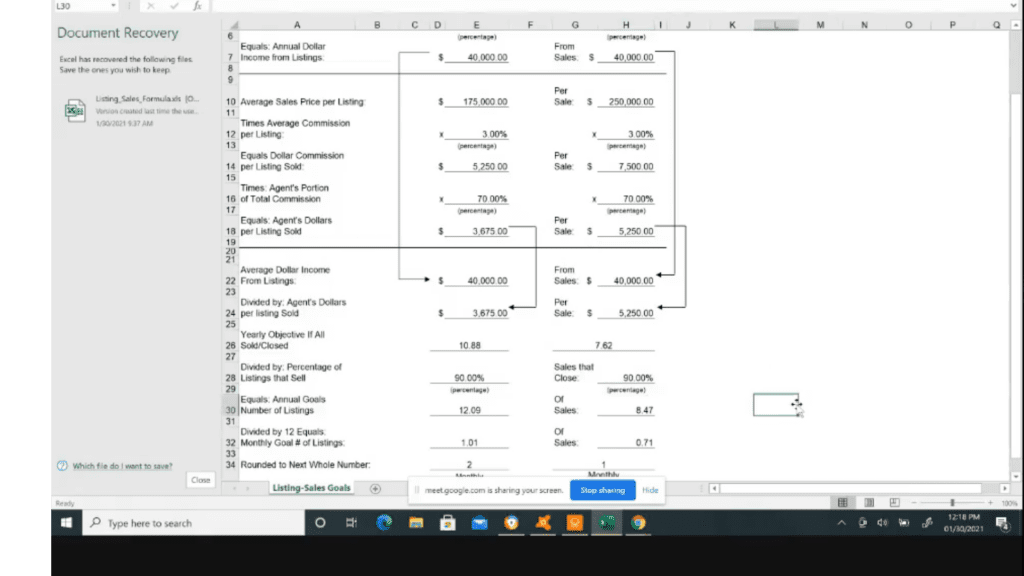Reverse Engineered Real Estate Sales: Your Step-by-Step Plan to Hit Your Income Goals. In the competitive world of real estate, sales success doesn’t just happen—it’s planned. Yet, many agents chase deals without a concrete roadmap, relying on chance instead of strategy. What if, instead of throwing darts at the board, you reverse-engineered your entire sales year based on the income you want to earn? By breaking down your annual goal into daily, actionable tasks, you’ll create a clear, laser-focused business plan that ensures your success. Let’s dive into how you can use reverse engineering to take control of your successful real estate career.
Step 1: Start With Your Annual Income Goal
Before diving into the numbers, you must answer one key question: How much money do you want to make this year?
This is not about setting arbitrary goals. Be intentional. Are you looking to hit six figures for the first time? Or are you aiming to double last year’s income? Maybe your target is $150,000, $200,000, or more. Whatever your number is, could you write it down? Your goal is the foundation of your plan, and it’s non-negotiable.
Step 2: Understand Your Market’s Average Home Sale Price
Every real estate market is unique. In some areas, the average home price might be $300,000; in others, it could be $1 million or more. To reverse-engineer your plan, you need to know the average home sale price in your market.
Let’s say your market’s average home price is $400,000. Keep this figure handy—it’s going to help you calculate how many homes you need to sell to hit your goal.

Step 3: Factor In Your Commission Split
Commissions are the lifeblood of real estate, but not every penny goes straight to your pocket. Most agents work under a commission split with their broker—common splits might be 70/30, 80/20, or 50/50. For this exercise, we’ll use an example of a 70/30 split.
If you sell a $400,000 home with a standard 3% commission, your total commission would be $12,000. After your broker takes their 30%, your take-home is $8,400 per transaction.
Now, take a moment to calculate what you actually earn per home sold after your commission split.
Step 4: Calculate How Many Homes You Need to Sell
Now that you know your goal, average home price, and commission split, it’s time to determine how many homes you need to sell.
Let’s break it down:
- Annual Income Goal: $150,000
- Net Commission Per Sale: $8,400
- Homes to Sell = $150,000 ÷ $8,400 = 18 Homes
If you want to make $150,000 this year, you’ll need to sell 18 homes. Adjust the math for your own income goals, home prices, and commission structure.

Step 5: Break It Down by Month and Week
Selling 18 homes in a year might feel like a big goal, but when you break it into monthly and weekly targets, it becomes manageable.
- 18 Homes Per Year ÷ 12 Months = 1.5 Homes Per Month
- 1.5 Homes Per Month ÷ 4 Weeks = 0.375 Homes Per Week
In simple terms, you need to close about 3-4 transactions every two months to stay on track. This breakdown helps make the goal feel achievable.
Step 6: Determine Your Daily Activities
Now comes the critical part—translating your goal into daily, actionable tasks. In real estate, success isn’t just about closings; it’s about what you do every day to create opportunities.
Let’s reverse-engineer further:
- How Many Leads Do You Need?
On average, it takes 20-30 leads to close one transaction (varies by agent and skill level). If you need 18 transactions, you’ll need approximately 360-540 leads per year. - How Many Conversations Does That Require?
Assuming a 10% conversion rate from conversations to leads, you’ll need to have 3,600-5,400 conversations per year. - Break It Down By Day:
- If you work 5 days a week for 50 weeks (accounting for some time off), that’s 250 working days per year.
- Conversations Per Day = 3,600 ÷ 250 = 14 Conversations Daily
Your daily task is to have at least 14 meaningful real estate conversations—this could include phone calls, texts, emails, or in-person meetings. These conversations build your pipeline and keep you on track to hit your goals.
Step 7: Track Your Progress
Tracking is the backbone of reverse-engineering. You can’t adjust your strategy if you don’t know where you stand. Use a CRM or simple spreadsheet to monitor:
- Number of conversations
- Leads generated
- Appointments set
- Contracts signed
- Closings
By reviewing your numbers weekly, you can spot trends and course-correct if necessary. For example, if you’re hitting 14 conversations daily but not generating leads, you may need to refine your script or target a different audience.
Step 8: Optimize Your Lead Generation Strategies
Not all leads are created equal. To ensure a consistent pipeline, diversify your lead generation efforts:
- Sphere of Influence (SOI): Reach out to past clients, friends, and family regularly.
- Online Marketing: Use social media, SEO, and paid ads to attract buyers and sellers.
- Open Houses: Host events to meet active buyers.
- Networking Events: Build relationships in your community.
Find what works best in your market and double down on those activities.
Step 9: Stay Consistent and Accountable
Reverse-engineering your real estate sales plan is only effective if you stay consistent. Motivation might waver, but discipline will carry you through. Consider partnering with an accountability buddy, coach, or team leader to keep you on track. Celebrate small wins—each closed deal is a step toward your bigger goal.
Final Thoughts: Success Is in the Numbers
Reverse-engineering your real estate sales plan isn’t just about hitting a financial goal; it’s about creating a focused, intentional approach to your business. By starting with the end in mind and breaking it into actionable daily tasks, you eliminate guesswork and position yourself for sustainable success.
The beauty of this method is its simplicity—know your numbers, do the work, and watch the results roll in. Your dream income is entirely within reach. Now it’s up to you to reverse-engineer it into reality.
Ready to take control of your real estate business? Start reverse-engineering today, and turn your goals into a step-by-step success plan. Let’s make this your best year yet!


Noodlemagazine Nice post. I learn something totally new and challenging on websites